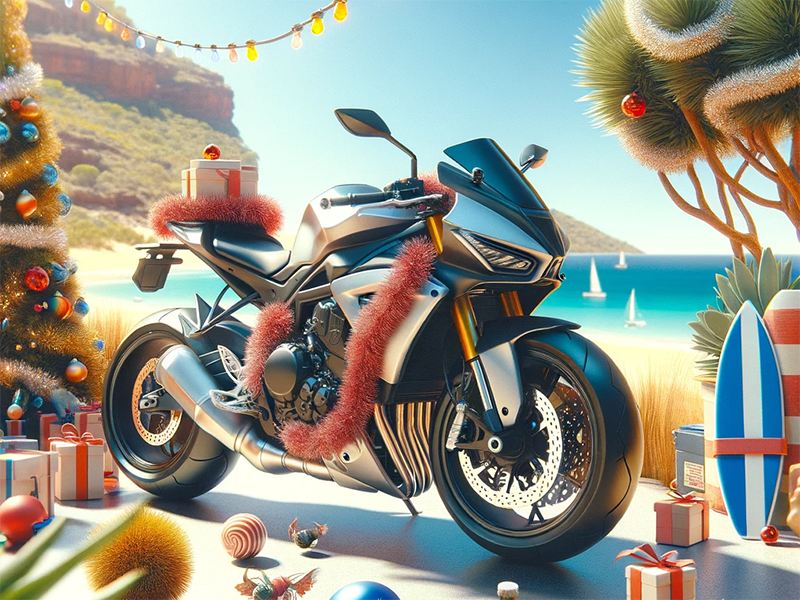Motorcycle riding is an exhilarating experience, offering a sense of freedom and adventure like no other. However, it’s important to remember that riding a motorcycle comes with its own set of risks and responsibilities, especially for new riders. In Australia, where motorcycle culture is thriving, it’s crucial for aspiring riders to be well-prepared and knowledgeable about the intricacies of riding on the roads. In this blog post, we’ll explore common mistakes new motorcycle riders should avoid, covering a wide range of aspects, including safety, motorcycle costs, licensing requirements, training courses, practice tests, skills, and techniques.
Safety First
Safety is paramount when it comes to motorcycle riding. New riders should prioritise the following aspects of safety:
- a) Protective Gear: Wearing appropriate protective gear is non-negotiable. This includes a certified helmet, gloves, armored jackets, pants, boots, and even a back protector. Investing in high-quality gear is essential to minimise the risk of injury in case of an accident.
- b) Maintenance: Regular maintenance of your motorcycle is crucial for safe riding. Ensure that your brakes, tires, lights, and other essential components are in good working condition. Regularly check the oil levels and tire pressure.
- c) Defensive Riding: Always assume other drivers might not see you. Defensive riding means being alert, anticipating potential hazards, and staying out of blind spots. Avoid tailgating, and maintain a safe following distance from other vehicles.
- d) Weather Conditions: Be aware of the weather conditions before heading out on your motorcycle. Rain, strong winds, and slippery roads can significantly affect your riding experience. Adjust your riding style accordingly and be prepared for sudden changes in weather.
- e) Alcohol and Drugs: Riding under the influence of alcohol or drugs is not only illegal but also incredibly dangerous. Always ride sober and avoid any substance that impairs your judgment and reflexes.
Licensing Requirements
Before you can hit the road on your motorcycle, you must obtain the appropriate motorcycle license in Australia. Licensing requirements can vary between states and territories, but generally, they include:
- a) Learner’s Permit: To start, you’ll need to obtain a learner’s permit, which allows you to ride under specific conditions, such as a maximum engine capacity and a zero blood alcohol concentration. You’ll usually need to complete a written test and undertake a practical riding assessment to obtain a learner’s permit.
- b) Provisional License: After gaining some experience on your learner’s permit, you can apply for a provisional license. This allows you to ride larger motorcycles and comes with fewer restrictions than the learner’s permit.
- c) Full Motorcycle License: To obtain a full motorcycle license, you’ll need to complete a probationary period on a provisional license, which may include additional training courses or assessments. Once you’ve successfully completed this period, you can apply for a full license.
Training Courses and Practice Tests
New riders should consider enrolling in a motorcycle training course in your state to gain valuable skills and knowledge. These courses typically cover the following:
- a) Basic Riding Skills: Training courses will teach you fundamental riding skills, including how to start, stop, steer, and maintain control of your motorcycle.
- b) Defensive Riding Techniques: You’ll learn how to identify potential hazards on the road, execute emergency maneuvers, and react to various traffic situations.
- c) Road Rules: Familiarise yourself with Australian road rules specific to motorcycles, such as lane filtering and helmet laws.
- d) Practice Tests: Many states and territories offer practice tests to help you prepare for the written exam required to obtain your learner’s permit. These practice tests are invaluable for new riders who want to ensure they pass the written exam on their first attempt.
Motorcycle Costs
Motorcycling can be a cost-effective mode of transportation compared to owning a car, but it’s essential to understand the financial aspects involved:
- a) Motorcycle Purchase: The cost of your motorcycle can vary significantly depending on the make, model, and age. Do your research and budget accordingly.
- b) Insurance: Motorcycle insurance is a must. It covers you in case of accidents, theft, or damage to your bike. Insurance premiums depend on factors like your riding experience, the type of motorcycle, and your location.
- c) Registration: You’ll need to register your motorcycle which can vary from state to state.
- d) Fuel and Maintenance: Motorcycles are generally more fuel-efficient than cars, but they still require regular maintenance. Budget for fuel, oil changes, tire replacements, and other routine upkeep.
- e) Riding Gear: High-quality riding gear can be a significant upfront cost, but it’s essential for your safety.
Skills and Techniques
Developing and honing your riding skills is an ongoing process. Here are some essential skills and techniques that every new rider should focus on:
- a) Balance and Control: Practice slow-speed maneuvers to improve your balance and control over the motorcycle. Mastering low-speed riding will help you feel more confident in traffic and tight spaces.
- b) Braking and Cornering: Understanding the intricacies of braking and cornering is critical. Learn to use brakes effectively and practice cornering techniques to safely navigate curves.
- c) Emergency Maneuvers: New riders should be prepared for unexpected situations. Practice emergency stops and swerves in a controlled environment to build your confidence and skills.
- d) Group Riding: If you plan to ride with others, learn the etiquette and safety protocols for group riding. Communication and coordination are essential when riding in a pack.
- e) Observation Skills: Develop your ability to scan the road, anticipate potential hazards, and make quick decisions based on the traffic conditions.
Motorcycle Choice
Choosing the right motorcycle is a crucial decision for new riders. Consider the following factors when selecting your first bike:
- a) Engine Size: Start with a motorcycle that has a manageable engine size for your level of experience. Smaller engine sizes (e.g., 250cc) are often recommended for beginners.
- b) Weight: A lighter motorcycle is generally easier to handle, especially for new riders. Look for bikes with a weight that you can comfortably manage.
- c) Riding Style: Consider your intended riding style. Are you primarily commuting in the city, going on long highway rides, or exploring off-road trails? Your bike choice should align with your riding goals.
- d) Ergonomics: Ensure the motorcycle’s ergonomics, including seat height and handlebar reach, are comfortable for your body size and shape.
- e) Safety Features: Some motorcycles come equipped with advanced safety features such as ABS (Anti-lock Braking System) and traction control. These can be beneficial for new riders.
Motorbike Road Rules and Laws in Australia
Understanding the road rules specific to motorcycles in Australia is essential for safe and legal riding. Some key regulations include:
- a) Helmet Laws: In Australia, wearing an approved helmet that complies with Australian standards is mandatory for all motorcycle riders. Failure to do so can result in fines and loss of points on your license.
- b) Lane Filtering: Many Australian states allow lane filtering, but the rules may vary. Always check the specific regulations for your location.
- c) Speed Limits: Observe posted speed limits, and be aware that speeding fines are enforced strictly. Speeding not only endangers your safety but also carries heavy penalties.
- d) Alcohol and Drugs: As mentioned earlier, riding under the influence is illegal and carries severe consequences.
- e) Mobile Phone Use: Using a mobile phone while riding is illegal and can result in fines and demerit points.
Practice and Experience
Experience is one of the most valuable assets for a motorcycle rider. As a new rider, consider the following tips for gaining experience safely:
- a) Gradual Progression: Start with short rides in low-traffic areas to build your confidence and skills. Gradually increase the complexity of your rides as you gain experience.
- b) Ride in Different Conditions: Challenge yourself by riding in various weather conditions and terrains. This will help you become a well-rounded rider.
- c) Ride with Experienced Riders: Riding with more experienced motorcyclists can provide valuable guidance and insights. They can offer tips, advice, and mentorship to help you improve.
- d) Continuous Learning: Never stop learning. Consider taking advanced riding courses to further enhance your skills and knowledge.
Motorcycle riding in Australia offers a unique and exciting way to explore the open roads and experience the thrill of the ride. However, it’s essential for new riders to approach this passion with a strong commitment to safety, education, and responsible riding. Avoiding common mistakes and staying informed about motorcycle costs, licensing requirements, training courses, practice tests, skills, and techniques is vital for a fulfilling and safe riding experience.
By following the guidelines provided in this comprehensive guide, new motorcycle riders can enjoy the freedom of the open road while minimising risks and maximising their riding enjoyment. Always remember that safety should be your top priority, and never underestimate the importance of continuous learning and improvement as a motorcyclist. Stay safe, stay informed, and enjoy the incredible journey that motorcycle riding in Austalia offers.



